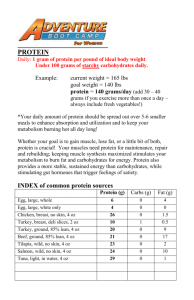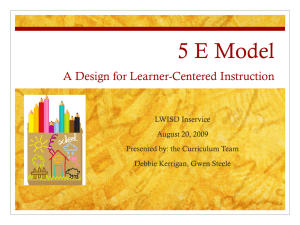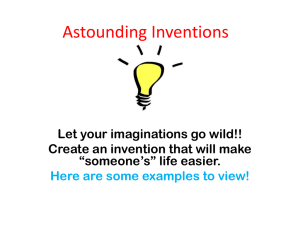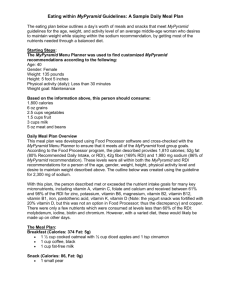Portion Distortion HS
advertisement
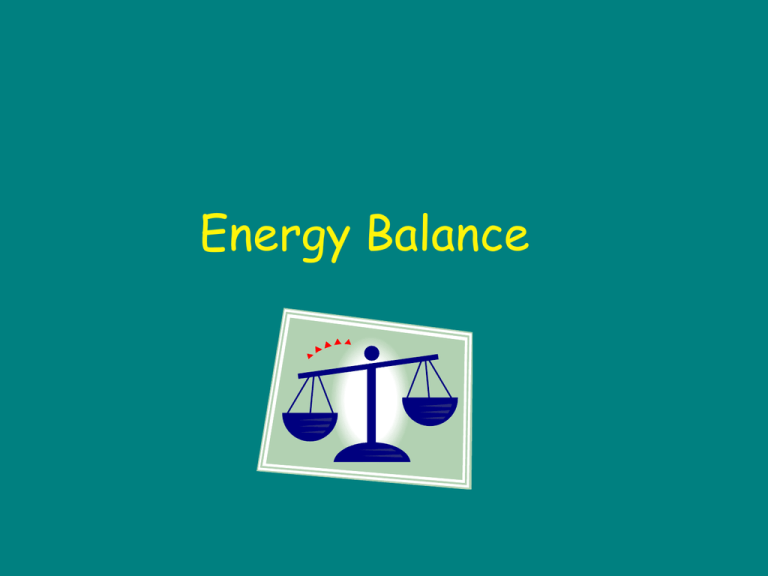
Energy Balance Project Sponsors • USDA project funded through the Supplemental Nutrition Assistance Program • School District of Philadelphia •Department of Nutrition Sciences, Drexel University Basic Maintenance Check How Do I GET Energy? What provides energy for our body? Food How do we measure energy in our food? Calories What nutrients in food provide calories? • Carbohydrates • Protein • Fat How Do I USE Energy? 1. Basal Metabolism energy to stay alive 2. Physical Activity energy needed to move our muscles on purpose 3. Thermic Effect of Food energy needed for digestion Energy In and Energy Out Energy In Carbohydrates: 1. Simple Sugars 2. Complex Carbohydrates (starches) Provide energy Protein Important for: • Muscle growth and repair • Building material for many body tissues Choose Wisely: • Fish, shellfish, lean meats • Trim fat and remove skin • Limit high fat processed meats • Choose beans, nuts, & seeds EAT MORE: FAT Unsaturated Fat • Vegetable oils, nuts, and fish EAT LESS: Saturated Fat • High fat dairy, fatty meats Trans Fat • Fried food & baked goods Needed for energy storage and vitamin absorption Can raise cholesterol and increase risk of heart disease Estimated Calorie Needs Activity Level Gender Age Female 14-18 Male Sedentary Moderately Active Active 1800 2000 2400 14-18 2000-2400 2400-2800 2800-3200 A Typical Day? BREAKFAST Cold cereal: DINNER Steak and potatoes: 1 slice whole wheat toast ½ cup cooked green beans 1 cup shredded wheat ½ cup sliced banana ½ cup fat-free milk 2 tsp all-fruit preserves Beverage: 1 cup fat-free chocolate milk LUNCH Turkey sandwich 1 whole wheat pita bread (2 oz) 3 ounces roasted turkey, sliced 2 slices tomato ¼ cup shredded lettuce 1 tsp mustard 1 Tbsp mayonnaise ½ cup grapes Beverage: 1 cup tomato juice 4 ounces broiled beef steak 2/3 cup mashed potatoes made with milk and 2 tsp tub margarine 1 tsp tub margarine 1 tsp honey 1 ounce whole wheat roll 1 tsp tub margarine Frozen yogurt and berries: ½ cup frozen yogurt (chocolate) ¼ cup sliced strawberries Beverage: 1 cup fat-free milk SNACKS 1 cup frozen yogurt (chocolate) ENERGY IN = 2000 Calories Energy Out How Do I Use Energy? 1. Basal Metabolism energy to stay alive (about 60%) 2. Physical Activity energy needed for muscular work (about 30-40%) 3. Thermic Effect of Food energy needed for digestion (about 10%) Why is Physical Activity Important? Being physically active can help you: •Increase your chances of living longer •Feel better about yourself •Decrease your chances of becoming depressed •Sleep well at night •Move around more easily •Have stronger muscles and bones •Stay at or get to a healthy weight •Be with friends or meet new people •Enjoy yourself and have fun Physical Activity and Your Health When you are not physically active, you are more likely to: • Get heart disease • Get type 2 diabetes • Have high blood pressure • Have high blood cholesterol • Have a stroke 2008 Physical Activity Guidelines For teenagers: • Get at least 60 minutes of physical activity each day •Most of it should be either moderate- or vigorous-intensity aerobic activity •Try to include muscle-strengthening activity on 3 days of each week and bonestrengthening activity on 3 days of each week Types of Physical Activity Aerobic •Moving continuously in a rhythm •Make you breathe harder and your heart beat faster •Running, jumping rope, swimming, dancing, biking Muscle-strengthening •Making muscles work more than usual •Climbing, tug-of-war, lifting weights, push-ups Bone-strengthening •Moving our bones against the force of gravity •Running, jumping rope, basketball, tennis, weight-lifting Balance and Stretching •Enhance physical stability and flexibility, which reduces risk of injuries •Gentle stretching, dancing, yoga, martial arts, and t’ai chi Intensity of Physical Activity Moderate Vigorous •Biking •Running •Hiking •Jumping rope •Rollerblading •Sports like soccer, hockey, basketball, swimming, and tennis •Brisk Walking So what happens when… Energy In Energy Out How Weight Gain Happens Consuming extra calories over time weight gain Activities How Much Do I Need? • Determine how many calories you need each day based on your activity level • See how much need from each food group for you calorie level Plan a Menu for a Day • Using the amounts you determined from the “How Much Do I Need” activity, plan out a menu for a day that would meet those needs

